Embark on Scotland's Unmissable 10 Walking Routes: A Guide to Nature, History, and Adventure
Step into Scotland's Wonders: Unveiling 10 of the Best Walking Routes with Kookoo Climb!
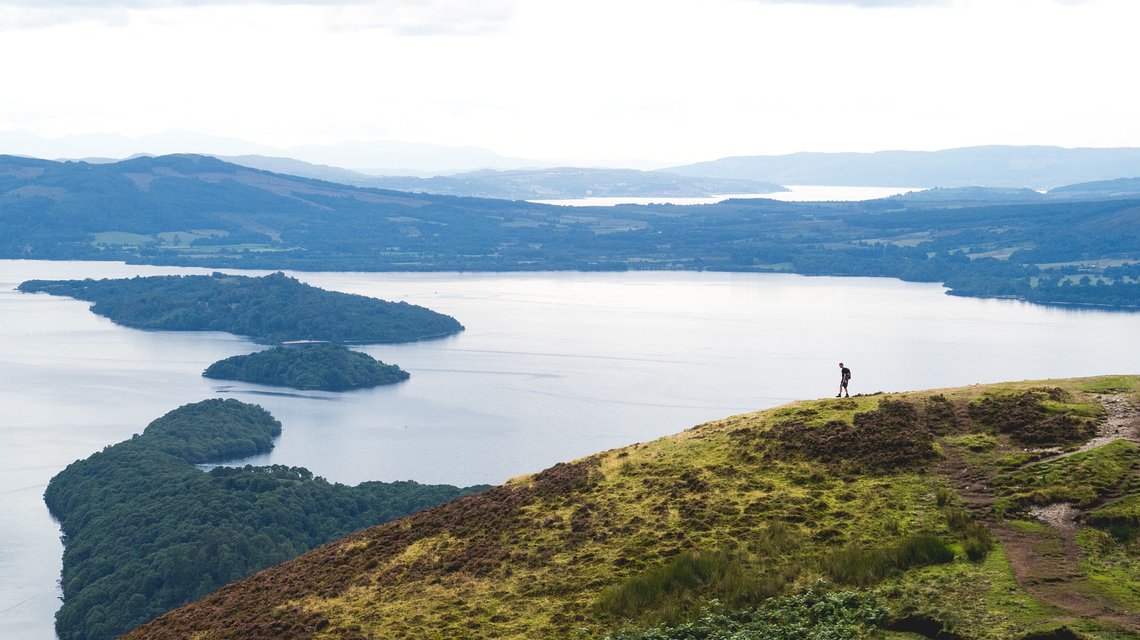
Tue 28 Nov 2023
Scotland's long-distance walking trails beckon, promising an immersive journey through nature, history, and culture. Whether you're a seasoned hiker or a casual explorer, these ten unmissable walking routes offer a kaleidoscope of Scotland's breathtaking landscapes. Lace up your boots and discover the beauty that awaits.
1. West Highland Way
- Distance: 96 miles
- Location: Milngavie to Fort William
The West Highland Way spans 96 miles, leading from Milngavie to Fort William. Traverse iconic attractions such as Mugdock Country Park, Loch Lomond, and Glen Nevis. Be mindful of camping restrictions around East Loch Lomond between March 1 and October 31. Summer can get busy, so consider walking in the spring or autumn for a more serene experience.
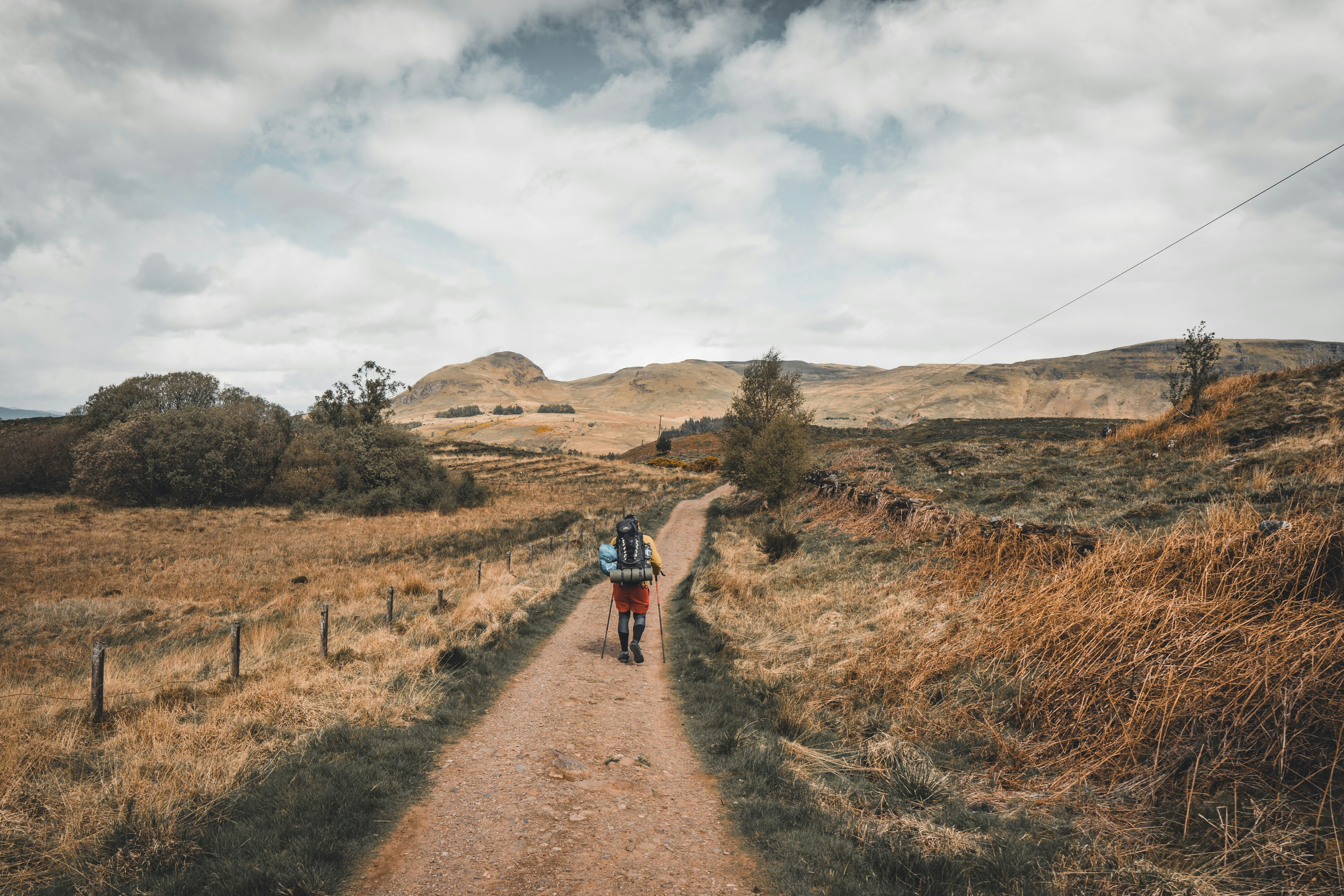
The West Highland Way on the way to Drymen
Nestled in the heart of Scotland, the West Highland Way beckons, a mesmerizing 154km trail that weaves its way through the Southern and Western Highlands. This scenic odyssey, stretching from the vibrant city of Glasgow to the historic Fort William, offers a week-long escapade into the diverse landscapes and breathtaking beauty of the Scottish wilderness.
Trail Highlights
1. Devil's Staircase Summit (548m): Challenge yourself to reach the pinnacle of the Devil's Staircase, a lofty peak between Kingshouse and Kinlochleven, standing at 548 meters. The panoramic views from this vantage point are nothing short of spectacular, providing a glimpse into the untamed beauty of the Highlands.
2. Diverse Terrain: The West Highland Way unfolds like a storybook, featuring a captivating narrative of varied terrains. From wide, smooth tracks in enchanting forests to twisty paths over expansive moorlands, undulating trails in dense woodlands, and meandering field paths, every step is a new chapter in this adventurous tale.
3. Accessibility and Versatility: While completing the entire West Highland Way is a week-long endeavor, the trail is easily accessible for trekkers aiming for shorter sections. This versatility allows hikers to tailor their experience, choosing segments that align with their preferences and time constraints.
The Highland Symphony
1. Awe-Inspiring Sights: Beyond its physical challenges, the West Highland Way is a visual feast. Delight in the ever-changing Highland panorama, with highlights including the mesmerizing stretch of Loch Lomond viewed from Rowardennan, the imposing Beinn Dorain near Tyndrum, the regal Buachaille Etive Mor near Kingshouse, and the revelation of Mamore mountains with Ben Nevis in the distance atop the Devil's Staircase.
2. Memorable Stages Along Loch Lomond: The stages along Loch Lomond are enchanting, offering a refreshing change with each step. Traverse from Balmaha to Rowardennan, relishing glimpses of the loch amid towering trees. The stretch between Rowardennan and Inverarnan is equally captivating, promising breathtaking views and serene moments.
3. Charm of Mountain Proximity: Experience the charm of walking in the close company of mountains between Inverarnan and Tyndrum. For an adrenaline-pumping adventure and unparalleled scenic beauty, the sections between Tyndrum and Bridge of Orchy, and Kingshouse and Kinlochleven, stand out as the crown jewels of this Highland sojourn.
Choosing Your Adventure Time
Best Season to Hike: The West Highland Way unveils its splendor throughout the seasons. Spring and autumn present milder temperatures and fewer crowds, allowing for a more intimate communion with nature. Summer showcases lush greenery, while winter transforms the landscapes into a serene, snow-covered wonderland. Each season paints a unique portrait of this Scottish masterpiece.
As you contemplate your journey along the West Highland Way, remember, if you seek a local guide to illuminate the path and enhance your experience, Kookoo Climb stands ready to assist. Let every step be a melody, every vista a masterpiece, and every moment an unforgettable Highland adventure.
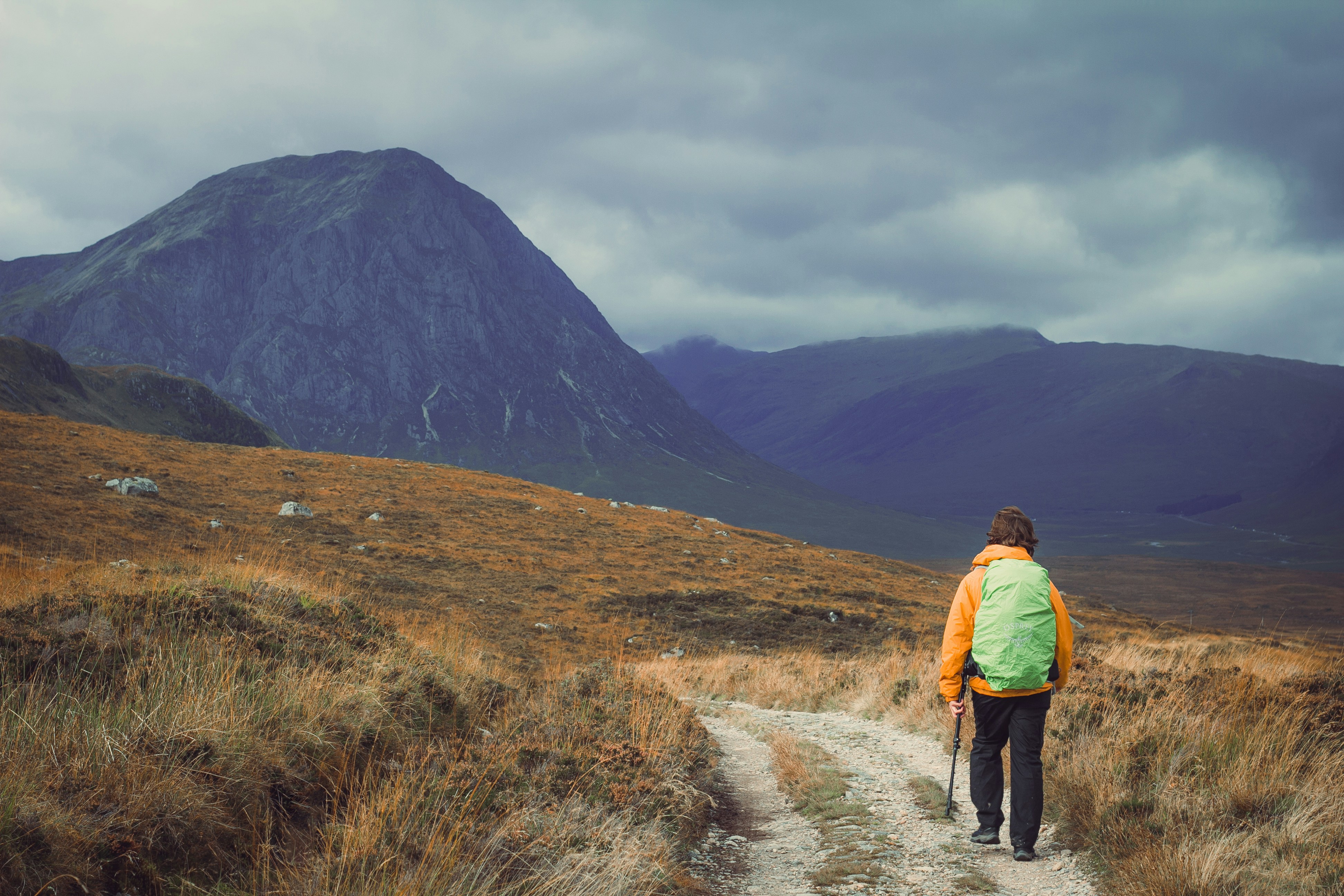
On the way to Glencoe and Buachaille Etive Mòr on the background
2. The Whithorn Way
- Distance: 143 miles
A pilgrimage route with a rich history, the Whithorn Way offers a 143-mile journey through Glasgow's Cathedral, rambling back roads, and stunning beach walks to Whithorn. The trail is newly mapped, allowing you to explore 13 historically significant segments. Dive into the ancient charm of this route and consider walking during the spring or autumn months. If you are a spiritual person, this may be your pick.

Glasgow's Cathedral
Embark on a sacred journey inspired by the legacy of St. Ninian, the 4th-century Christian saint, miracle worker, and possibly the first Christian missionary to grace the landscapes of Scotland. The pilgrimage unfolds like a chapter from ancient history, guiding you through majestic ruins, historic abbeys, and breathtaking coastal vistas. Begin your odyssey at the venerable Glasgow Cathedral, and as you trace the footsteps of St. Ninian, witness the rich tapestry of Scottish heritage.
Glasgow to Paisley: A Spiritual Prelude
Commence your pilgrimage at the revered Glasgow Cathedral, where echoes of centuries past linger in the air. From here, the trail leads to Paisley's ancient abbey, a testament to the enduring spiritual significance woven into the fabric of Scotland's history.
Coastal Reverie and Hillside Serenity
As you venture beyond, the pilgrimage takes you through undulating hills, quaint Scottish towns, and the picturesque coastal landscapes of Dumfries and Galloway. The journey is not merely a physical one; it's a spiritual odyssey that resonates with the essence of St. Ninian's teachings.
Ninian’s Chapel: A Humble Sanctuary by the Sea
In Dumfries and Galloway, a humble yet profound sight awaits – Ninian's Chapel. Nestled on seaside rocks, this unassuming structure, devoid of a roof, emanates a primal spirituality. The simplicity of the chapel contrasts with the grandeur of its spiritual significance.
Ninian’s Cave: Overlooking the Irish Sea
Continuing along the coast, you'll discover Ninian's Cave, a sacred space that overlooks the vast expanse of the Irish Sea. This coastal sanctuary deepens the pilgrim's connection to nature and spirituality, offering a moment of contemplation amidst the rhythmic sounds of the sea.
Easy Wanderings and Culinary Delights
Beyond the spiritual, the pilgrimage embraces the soul of Scotland. Experience the ease of coastal and hill walking, finding comfort in accommodations and pubs that boast local beers and culinary specialties. The pilgrimage becomes a holistic exploration, engaging not just the spirit but also the senses.
Highlights of the Journey
St. Ninian’s Wild Places of Pilgrimage: Traverse the landscapes that St. Ninian once graced, experiencing the wild places that resonate with spirituality.
Multi-Layered Scottish Heritage: Uncover the layers of Scottish history as you encounter ancient ruins, abbeys, and churches along the Firth of Clyde.
Countless 'Glad to Be Alive' Moments: Let each step be a celebration of life, as the pilgrimage unfolds countless moments of joy, gratitude, and spiritual awakening.
Embark on this fortnight-long pilgrimage, where every step echoes with the footsteps of a saint, and every moment is a celebration of life's profound beauty. As you immerse yourself in the pilgrimage, discover the true essence of Scotland's spiritual and cultural heritage.
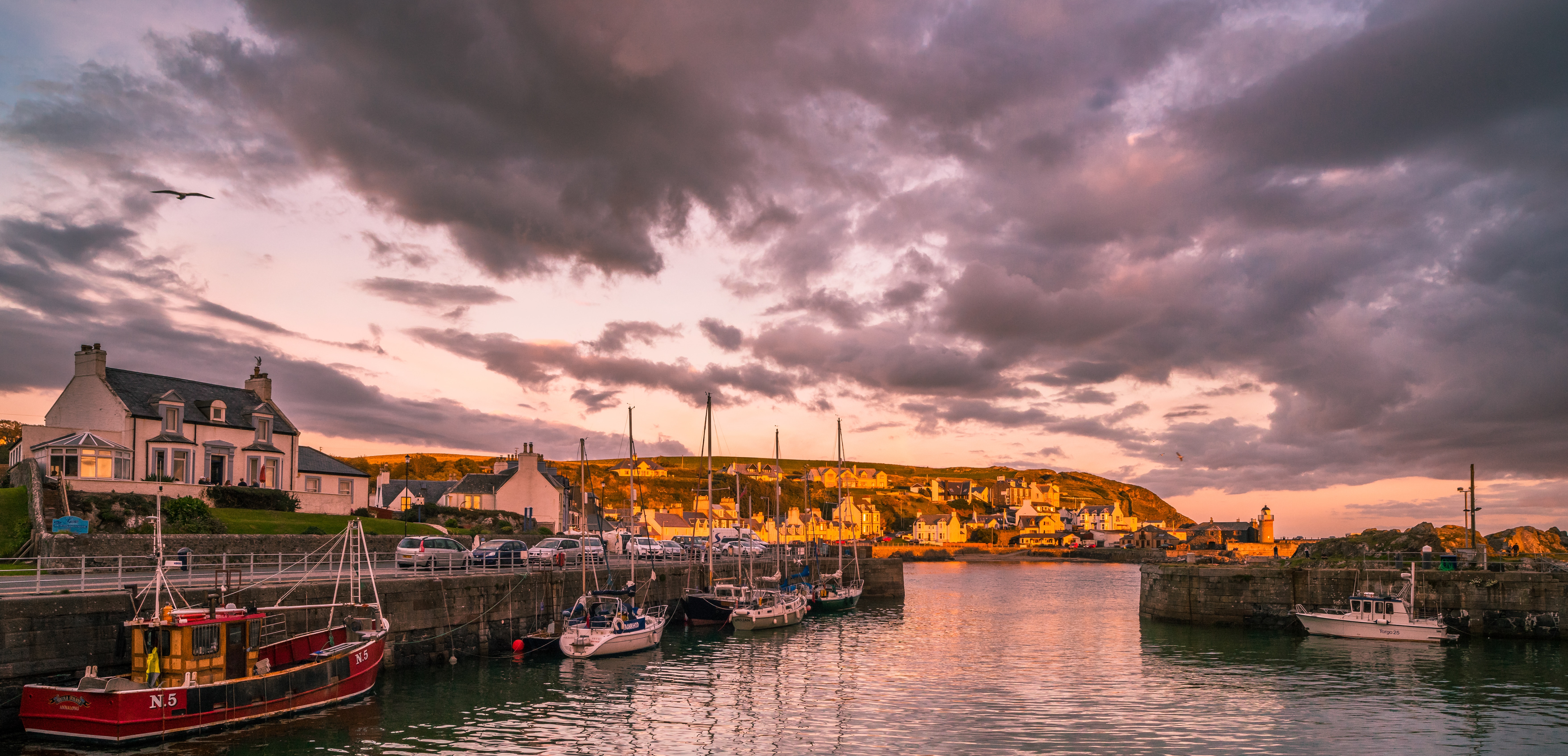
Portpatrick, Dumfries & Galloway
3. John Muir Way
- Distance: 134 miles
- Location: Helensburgh to Dunbar
Traverse central Scotland from Helensburgh to Dunbar, covering 134 miles of diverse landscapes. Explore Loch Lomond, Edinburgh, and the Union and Forth & Clyde canals' industrial heritage. With good transport links between sections, the John Muir Way accommodates shorter trips, making it suitable for various schedules.
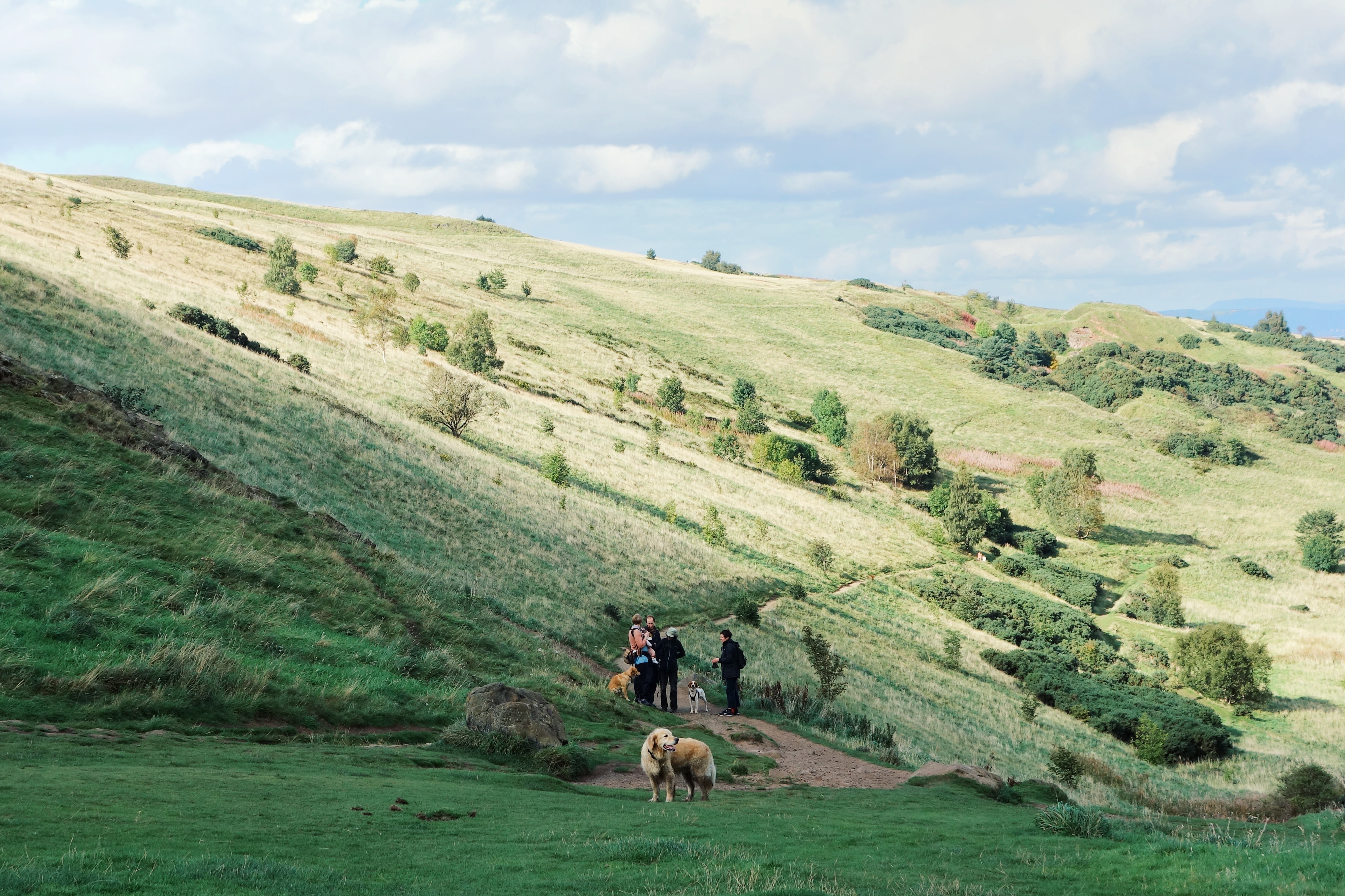
The John Muir Way in Edinburgh and Holyrood Park
Embark on a captivating journey along the John Muir Way, a trail that weaves through the heart of Scotland, offering a diverse tapestry of landscapes, history, and cultural gems. This scenic odyssey, inspired by the renowned naturalist and environmentalist John Muir, unfolds in ten distinct sections, each brimming with its own unique charm.
1. Helensburgh to Balloch Length: 9 miles, 14.4 km
Commencing the trail at Helensburgh's waterfront, marked by a circular stone plinth adorned with John Muir quotes, this section is a delightful 9-mile journey. As you set forth from this seaside holiday town, you'll be treated to the mesmerizing beauty of Helensburgh's pier and engraved footprints, immersing you in the spirit of adventure.
2. Balloch to Strathblane Length: 18.5 miles, 29.6 km
Navigate through Balloch Castle Country Park, savoring the breathtaking views along the shores of Loch Lomond. This 18.5-mile stretch introduces you to the Kilpatrick Hills, offering a genuine upland experience and a sense of untamed wilderness that echoes the spirit of John Muir.
3. Strathblane to Kilsyth Length: 13 miles, 20.8 km
Covering a 13-mile stretch, this leg presents a flatter and more accessible terrain compared to previous sections. Enjoy the ease of walking through flat landscapes, embracing the tranquility that characterizes this part of the John Muir Way.
4. Kilsyth to Falkirk Length: 13 miles, 20.8 km
East of Kilsyth, the trail meets the historic Forth and Clyde Canal, once a bustling shipping link in John Muir's era. Today, it offers a serene backdrop for activities like fishing and cycling, allowing you to immerse yourself in the quiet beauty of the waterways.
5. Falkirk to Linlithgow Length: 8.5 miles, 13.6 km
Falkirk unfolds as a bustling town with attractions like the Falkirk Wheel and The Helix. This 8.5-mile section invites you to explore the pedestrianized town center and showcases two of Scotland's iconic landmarks, making it a must for sightseeing enthusiasts.
6. Linlithgow to South Queensferry Length: 14 miles, 22.4 km
Leaving the historic town of Linlithgow, this segment guides you through rural countryside. The Fisherrow walk provides splendid views, a route once traversed by fishermen's wives selling their catches. Embrace the rural charm and picturesque landscapes.
7. South Queensferry to Edinburgh Length: 15.5 miles, 24.8 km
With panoramic views of Scotland's iconic Forth bridges, South Queensferry offers a visual feast. Capture the majesty of these structures during sunset or dawn, adding a touch of magic to your 15.5-mile journey towards Edinburgh.
8. Edinburgh to Prestonpans Length: 10 miles, 16 km
After immersing yourself in Edinburgh's sights and flavors, this section takes you via Musselburgh. Delight in the spectacle of horse races at Musselburgh Racecourse before joining the coast, where wading wildlife and coastal vistas await.
9. Prestonpans to North Berwick Length: 16.5 miles, 26.4 km
Beyond Prestonpans' historical sites, the route unfolds, passing the former site of Cockenzie Power Station. The journey continues east to Seton Sands, treating you to expansive beach views and a glimpse of Scotland's industrial heritage.
10. North Berwick to Dunbar Length: 15 miles, 24 km
The final stretch from North Berwick to Dunbar is a 15-mile sojourn that unveils the opportunity to climb North Berwick Law. Revel in panoramic views of the town, Arthur’s Seat in Edinburgh, Tantallon Castle, and the iconic Bass Rock. The summit, adorned with whale jawbones, offers a fitting conclusion to this remarkable Scottish adventure.
Embark on the John Muir Way, where each section is a chapter in a compelling story, narrated by the landscapes and history of Scotland. Experience the spirit of John Muir as you traverse through diverse terrains, from coastal wonders to rural landscapes, and create memories that echo the footsteps of this environmental pioneer.
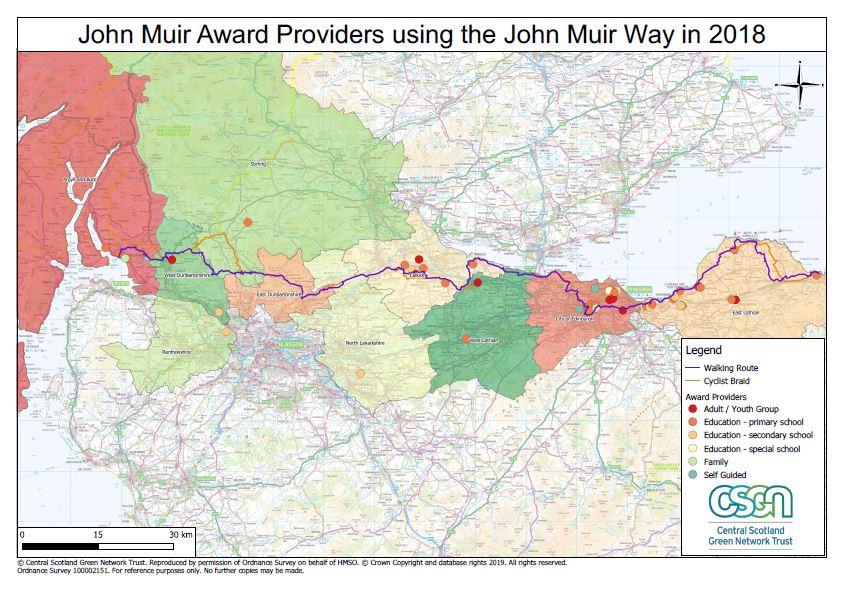 John Muir Way. Source: John Muit Trust
John Muir Way. Source: John Muit Trust
4. The Loch Ness 360° Trail
- Distance: 80 miles
- Location: Circumference of Loch Ness
An epic adventure awaits along the Loch Ness 360° Trail, a versatile route catering to walkers, cyclists, runners, and outdoor enthusiasts. This trail forms a complete loop around Loch Ness, connecting the Great Glen Way and the South Loch Ness Trail. Spanning 80 miles, it's more than a trail; it's an experience. Commence your journey in the Highland Capital of Inverness or join the trail at any point, soaking in the beauty of Loch Ness. Uncover the wonders of this Scottish gem, where one visit is never enough.
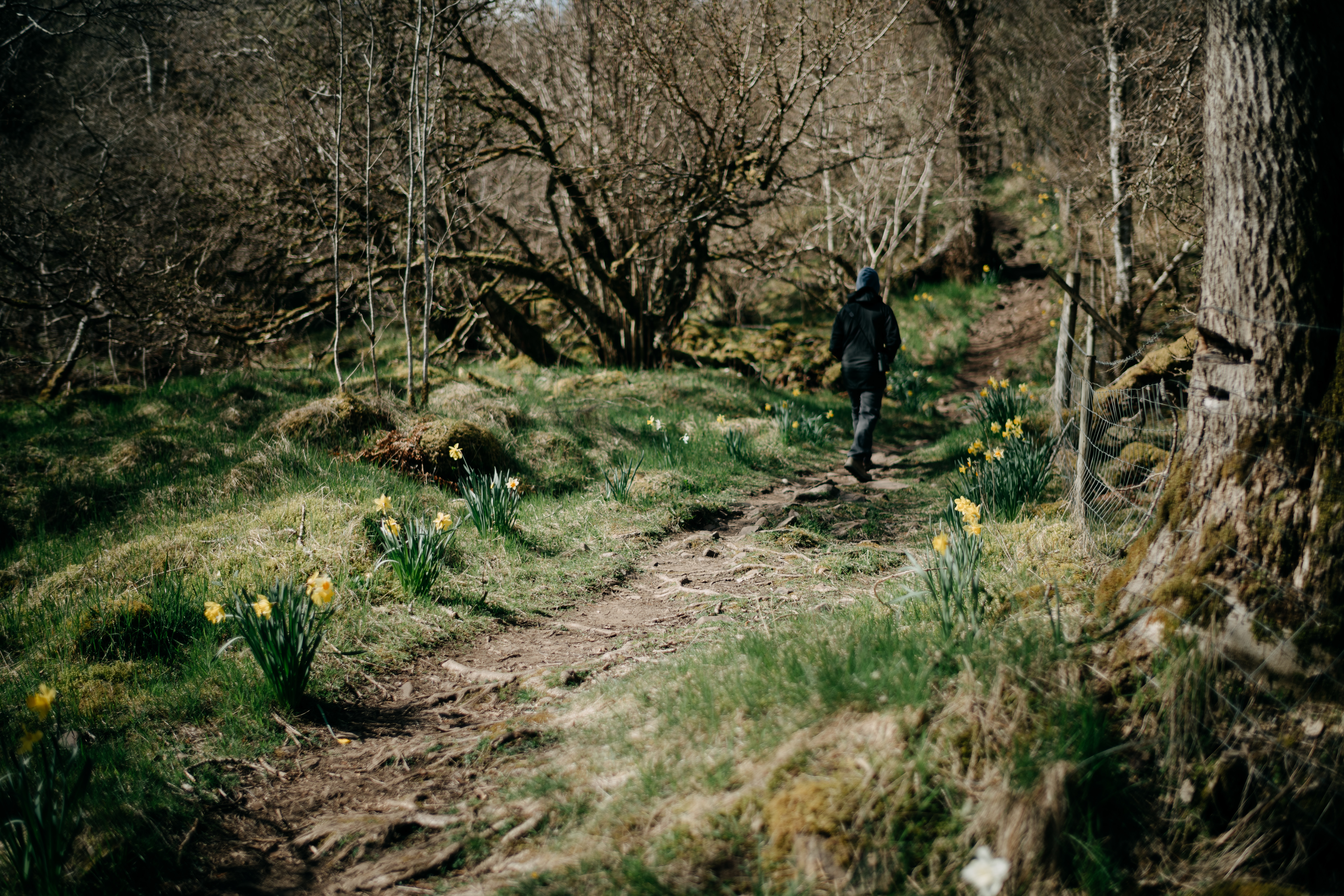
Hiking in the Loch Ness area
Unveil the majesty of Loch Ness, an iconic jewel nestled in the heart of the Highlands, with the Loch Ness 360 trail – a 130km circular trek that promises to immerse walkers, runners, and cyclists in the breathtaking allure of this Scottish wonder.
Highlights of the Journey
Beginning and Ending in Inverness Commencing and concluding in Inverness, the capital of the Highlands, this epic adventure unfolds over 130km, inviting enthusiasts to traverse a well-pathed yet occasionally challenging route that encapsulates the very essence of Loch Ness.
Six Sections of Splendor For those embarking on this journey, the Loch Ness 360 trail is thoughtfully segmented into six distinct sections. Each leg of the trek offers a new perspective of the landscape, ensuring that participants encounter a diverse range of terrains and experiences.
The Great Glen Way and South Loch Ness Trail This exceptional route seamlessly integrates both the Great Glen Way and the South Loch Ness Trail, presenting a holistic exploration of the region's natural wonders. Meander through well-marked paths adorned with thistles for the Great Glen Way and charming blue waymarks featuring squirrels for the South Loch Ness Trail.
Duration and Challenges With an average completion time of 6-7 days for walkers, the Loch Ness 360 trek is a testament to the endurance and determination of those seeking an immersive Highland experience. The journey unfolds through a tapestry of landscapes, including elevated views of Loch Ness, meandering woodlands, quaint villages, and a variety of terrains encompassing paths, forestry tracks, boggy stretches, and minor roads.
Adventure Awaits While the trail offers a grand adventure, it also presents challenges. Participants should be prepared for steep inclines, uneven, narrow paths, and diverse terrain. An element of hill walking experience and good fitness are recommended to conquer the Loch Ness 360 with confidence.
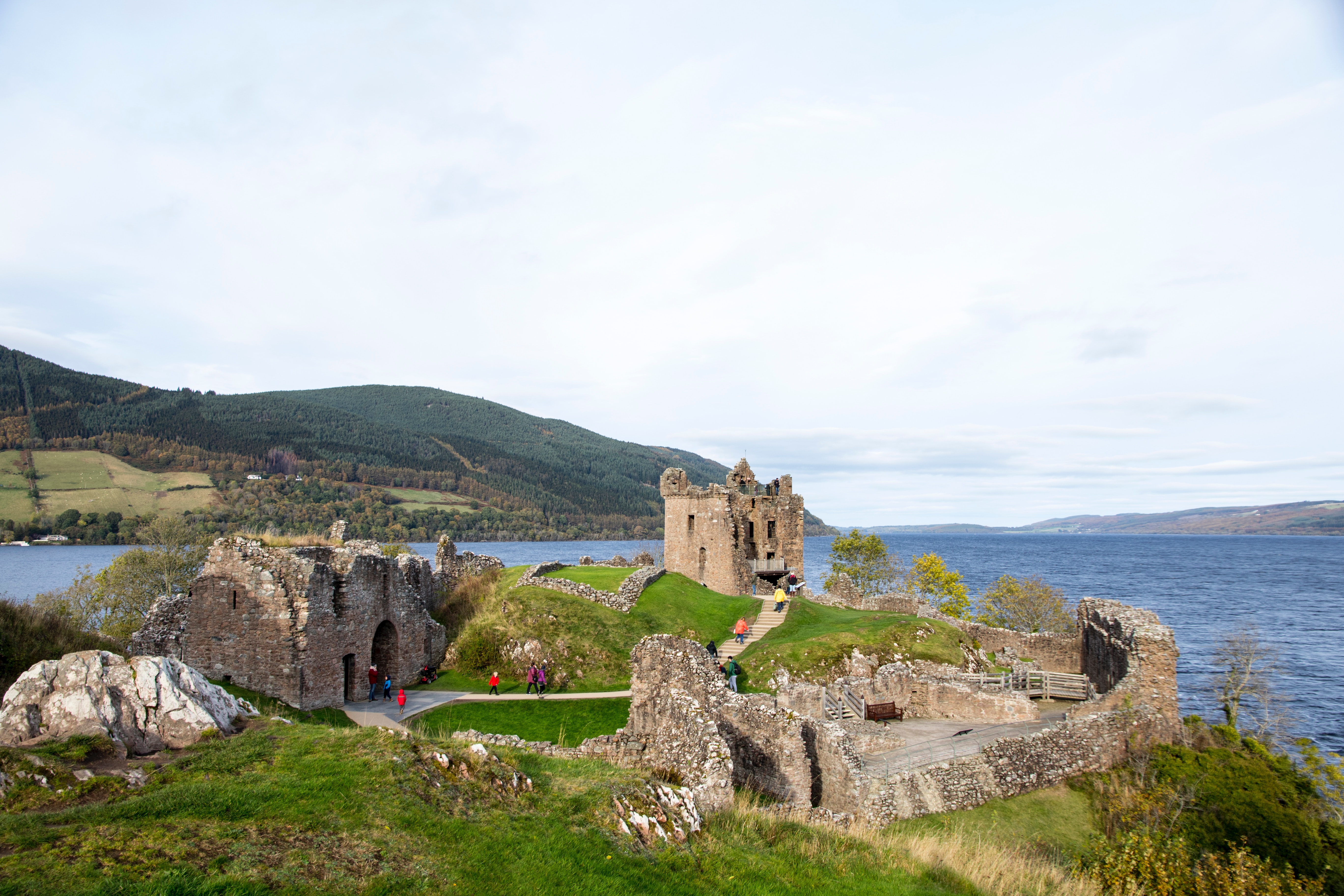
Urquhart Castle at the banks of Loch Ness
Conclusion: Embrace the Highland Spirit
The Loch Ness 360 trail is not merely a trek; it's an odyssey through the very heart of the Highlands. With each step or pedal rotation, participants absorb the essence of Loch Ness – its mystique, grandeur, and the untamed beauty that has captivated travelers for generations.
Whether you choose to walk, run, or cycle, Loch Ness 360 promises an immersive journey that transcends the ordinary. Prepare to be enthralled by the changing panoramas, enchanted woodlands, and the challenge that comes with conquering a trail that bears witness to the Highland spirit.
Embark on the Loch Ness 360 – where every section is a chapter, and the entire trail is a narrative of Highland allure, waiting to be explored.
5. Fife Coastal Path
- Distance: Over 183km
- Location: Forth to Tay Estuaries
Linking the estuaries of Forth and Tay, the Fife Coastal Path unfolds over 183km through the diverse landscapes of Fife. This route connects picturesque former fishing villages, including the historic home of golf, St Andrews. Golden beaches, enchanting woods, and nature reserves punctuate the path, weaving through industrial towns like Kirkcaldy and Leven. Immerse yourself in history, from the remnants of coalyards to ruined castles and ancient carvings in the Wemyss caves. While some sections can be muddy, the Fife Coastal Path offers straightforward walking, with longer and more remote stretches between Crail and St Andrews, and from Balmerino to Newburgh.
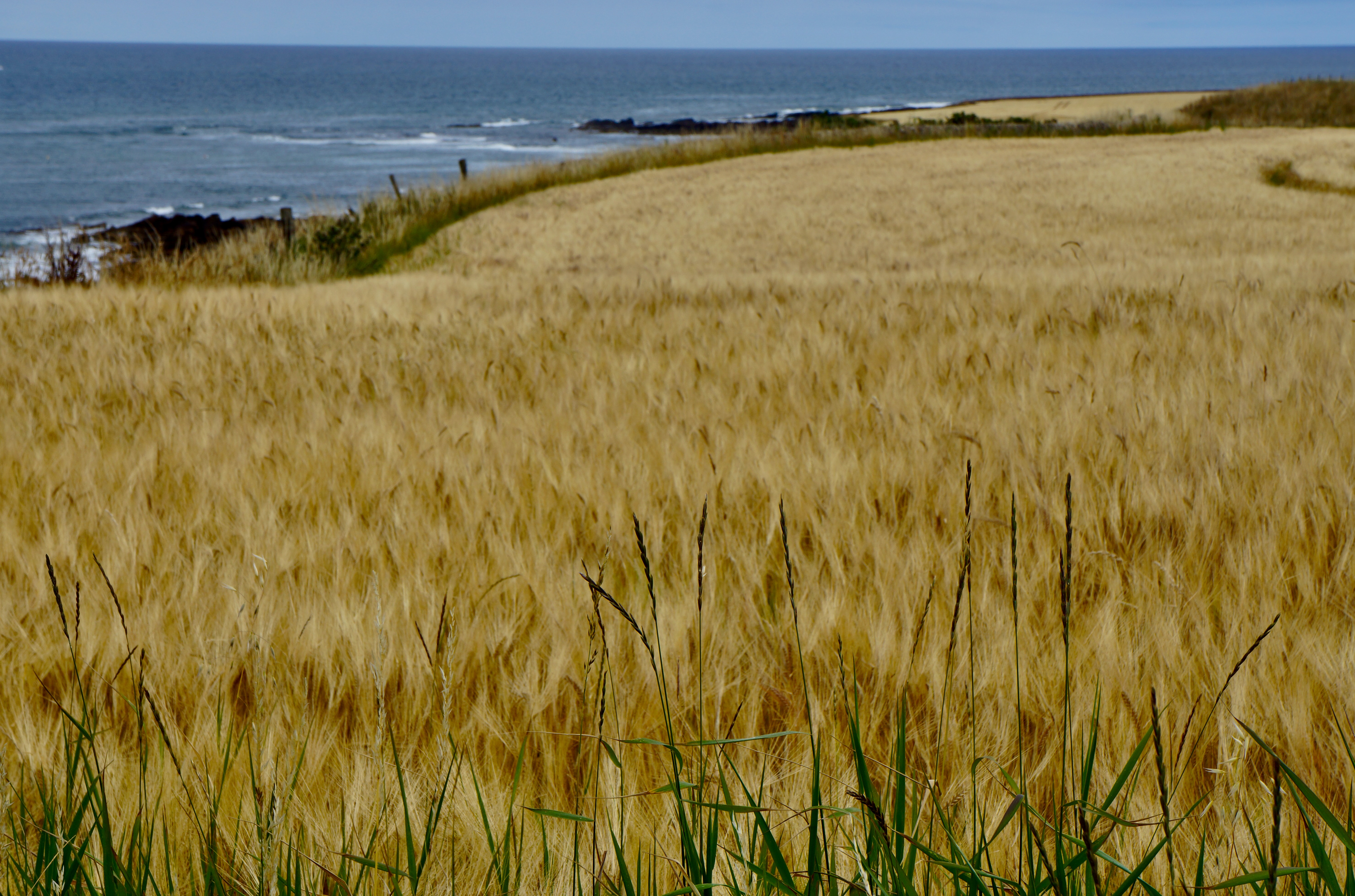
Some of the landscapes you'll walk on the Fife Coastal Path
Route Type and Direction
Embark on a linear journey with the preferred direction starting from Kincardine-on-Forth, strategically placing the prevailing wind at your back for the majority of this anti-clockwise circuit around the Fife peninsula. The route unfolds from the Firth of Forth to the Firth of Tay, offering a diverse landscape that transitions from level paths to rugged rocky beaches.
Overview: A Tapestry of Fife's Richness
Commencing from the Firth of Forth and concluding on the Firth of Tay, the Fife Coastal Path is a captivating adventure through a tapestry of terrains. Traverse former coal mining towns in central Fife, experience the vibrancy of the cosmopolitan university city of St Andrews, and explore the charming fishing villages and harbors of Fife’s East Neuk, contrasting with the industrial areas of the west. The journey reveals award-winning sandy beaches, significant estuaries, wildlife reserves, farmlands, woodlands, and the option of the Elie Chainwalk, Scotland’s hidden via ferrata.
Highlights: Icons and Hidden Gems
- Witness the grandeur of the three iconic bridges spanning the River Forth.
- Immerse yourself in the historic ambiance of the village of Culross.
- Discover 15 major award-winning beaches along with numerous smaller, secluded ones.
- Explore the picturesque fishing villages of Fife’s East Neuk.
- Experience the natural wonders of the Eden Estuary Nature Reserve and Tentsmuir beach and forest.
- Encounter castles, windmills, lighthouses, churches, and abbeys along the way.
Be Aware: Practical Considerations
- Certain sections, notably between Balmerino and Newburgh, are challenging to access via public transport.
- Some path segments are only accessible at low tide; diligent checking of local tide times is advised.
- Exercise caution when near golf courses; stick to the designated path, avoid greens and fairways, and steer clear of distracting players.
The Challenge: Walk at Your Pace
The Fife Coastal Path accommodates walkers of varying preferences and capabilities. Divided into 8-10 sections, each varies in length, gradient, and terrain. Waymarked consistently, the trail doesn't necessitate advanced map-and-compass skills. While it serves as an excellent choice for a first long walk, allowing ten days for the entire route is advisable. Originally spanning from North Queensferry to Newport-on-Tay, some companies still offer the shorter 81-mile route. The extended Kincardine start involves a 16.8-mile (27-km) initial section to North Queensferry, with the final stretch to Newburgh measuring 18.3 miles (29.5 km).
Accommodation: Plan Ahead for Comfort
Accommodation options abound, except for the stretch from Balmerino to Newburgh where early bookings are recommended. Alternatively, for those seeking a more immersive experience with nature, wild camping is legally permitted in Scotland under the Scottish Outdoor Access Code, provided it is practiced responsibly.
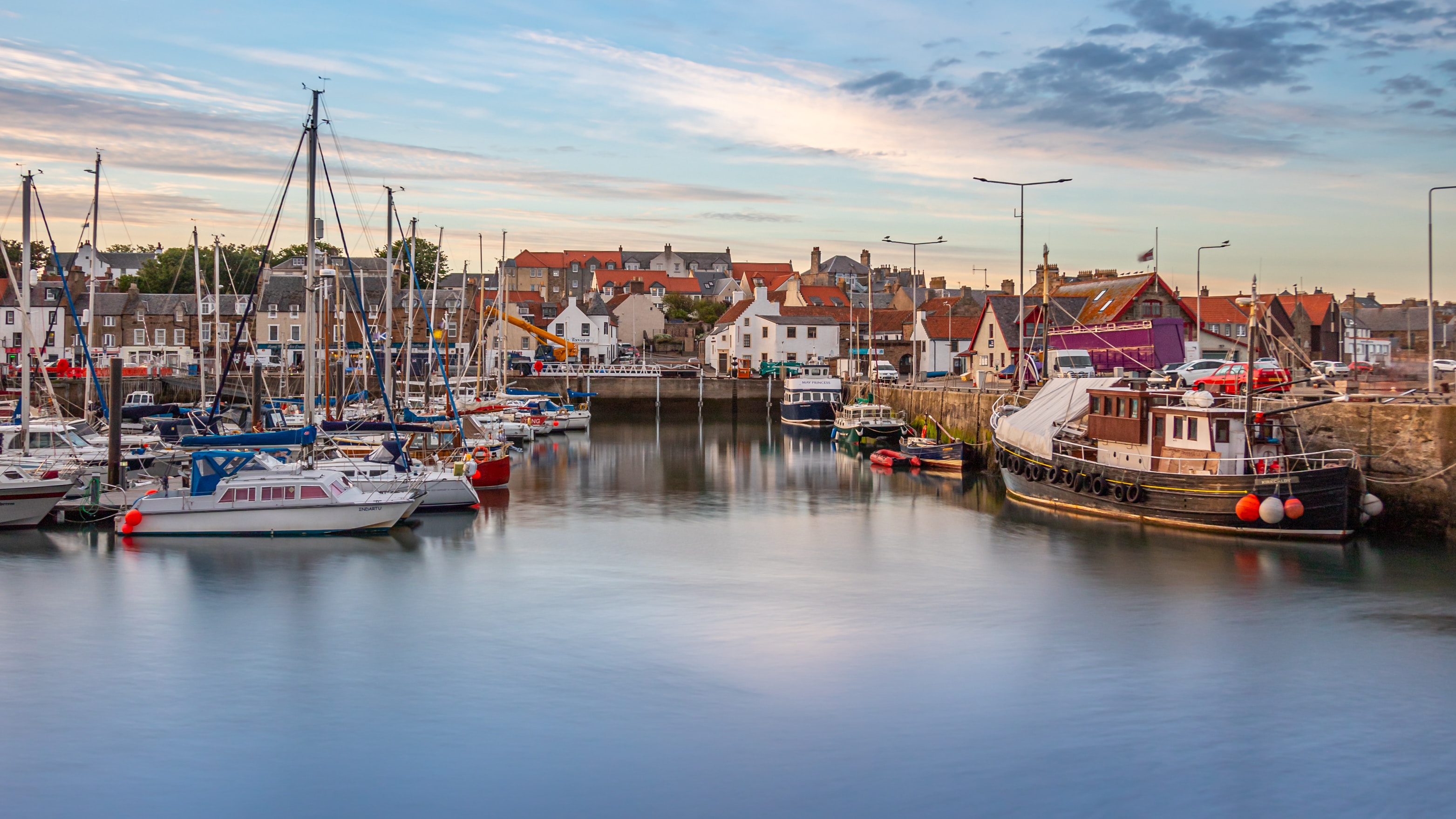
Anstruther on the coast of Fife
6. The Southern Upland Way
- Distance: 212 miles
- Location: Portpatrick to Cockburnspath
For a leisurely stroll along Scotland's stunning coast, explore the Southern Upland Way. This coast-to-coast route spans 212 miles from Portpatrick on the west coast to Cockburnspath in the east. Marvel at the spectacular views and varied landscapes shaped by glaciation. While certain sections present challenges for experienced walkers, there are shorter, gentler routes suitable for families and those seeking a more relaxed pace.
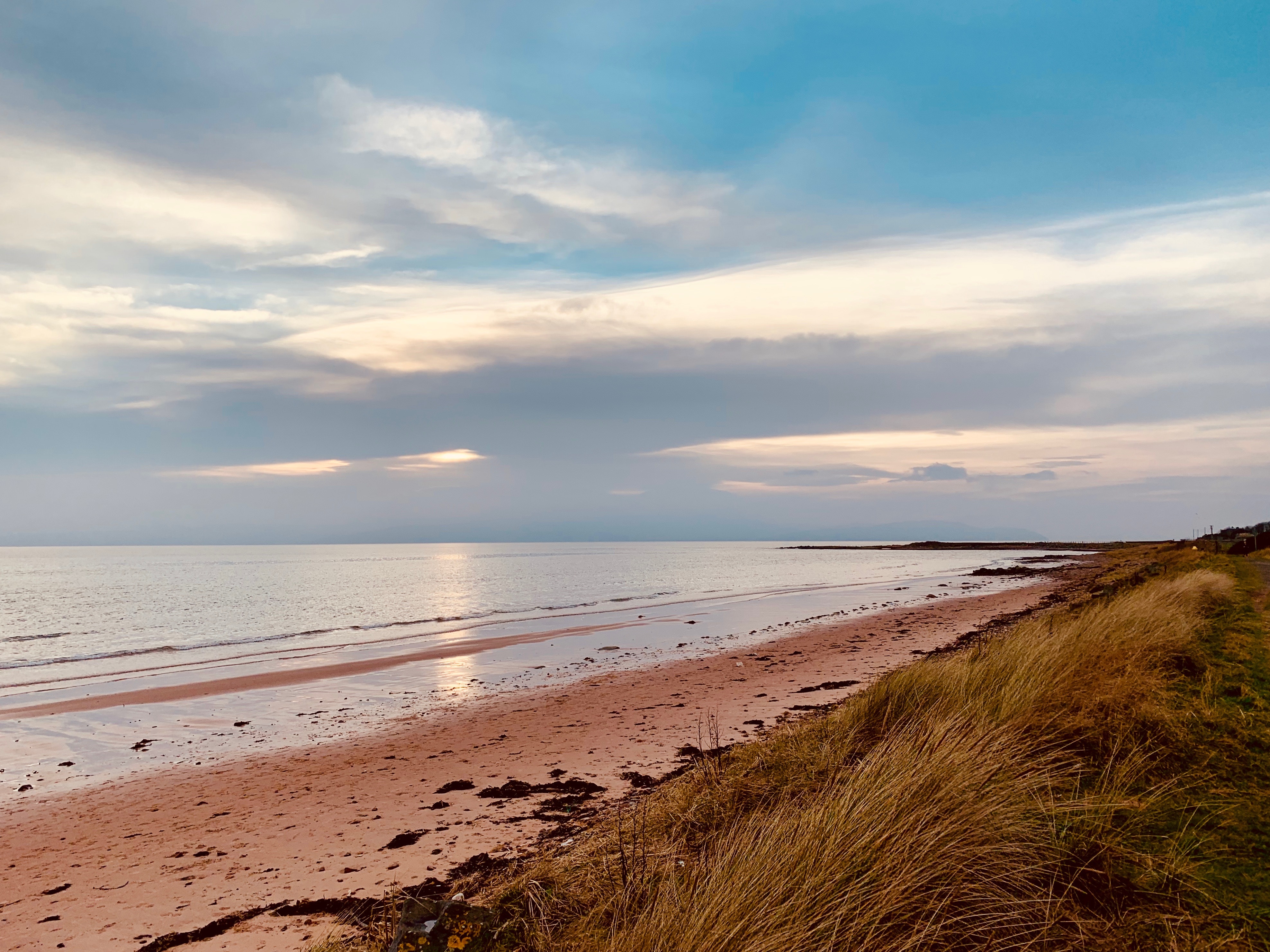 The magnificent coast of Ayrshire
The magnificent coast of Ayrshire
Introduction: A Trail of Pioneering Significance
Unveiled in 1984, the Southern Upland Way proudly stands as the UK’s inaugural officially recognized coast-to-coast long-distance route. Distinguishing itself from conventional trails, this path boldly intersects the lines of the hills, crafting a unique narrative that unfolds through diverse landscapes resonating with both untamed nature and storied human history, including the echoes of ruined abbeys and castles.
Highlights: Nature's Grandeur and Historical Riches
- Portpatrick: Gaze across the Irish Sea to the majestic Mourne Mountains.
- Rhins of Galloway: Revel in panoramic views encompassing the Isle of Man, Ailsa Craig, and the Kintyre peninsula.
- Galloway and Southern Ayrshire Biosphere: Immerse yourself in the harmonious blend of nature and human activity.
- Loch Trool, St Mary’s Loch, and the River Tweed: Traverse scenic waterside landscapes.
- Wanlockhead: Experience Scotland's loftiest village at an altitude of 410m/1350ft.
- Views from the Three Brethren: Discover three ancient hilltop cairns dating back to the 1500s.
- Traquair House: Step into Scotland's oldest inhabited house, visited by 27 Scottish monarchs.
- Abbotsford House: Explore the historic residence of writer Sir Walter Scott, housing personal and historic treasures.
Be Aware: Practical Considerations for hikers
- Challenging Stretches: Some segments are demanding and lengthy; preparedness and proper equipment are crucial.
- Weather Variability: Hill conditions can change swiftly, requiring essential map-and-compass skills in any season.
- Wild Camping: If opting for wild camping, flexibility in daily distances is achievable based on fitness and load.
The Challenge: A Test of Fortitude and Skill
Embarking on the full Southern Upland Way demands robust fitness and hiking experience. Negotiating extended, strenuous sections in exposed uplands necessitates thorough preparation and emergency readiness. While the trail is well-marked, proficiency in navigation with a map and compass becomes pivotal in poor visibility. Completion time varies, spanning 12 to 16 days for most walkers, with potential extensions if rest days are incorporated.
Accommodation: Plan Strategically for Comfort
Villages and towns along the route offer a range of B&Bs and hotels; however, meticulous planning is advised due to limited accommodations in certain sections. The official website provides a map showcasing campsites, B&Bs, and hotels along or near the Way. Additionally, there are bothies and camping options, aligning with Scotland's policy on responsible wild camping under the Scottish Outdoor Access Code. Walkers with camping gear can tailor daily distances according to personal preferences.
7. The Great Glen Way
- Distance: 117km
- Location: Fort William to Inverness
The Great Glen Way stands as a popular and challenging walking route, connecting the towns of Fort William and Inverness. Stretching 117km across the Highlands, this trail follows the natural fault line that divides Scotland's coasts. Commencing at the end of the West Highland Way, the journey unfolds through breathtaking spots such as Loch Lochy, Loch Oich, the forests surrounding Loch Ness, and the towpath of the Caledonian Canal, a masterpiece crafted by Thomas Telford. Walkers often choose different stages, starting from towns and villages like Gairlochy, Laggan, Fort Augustus, Invermoriston, and Drumnadrochit.
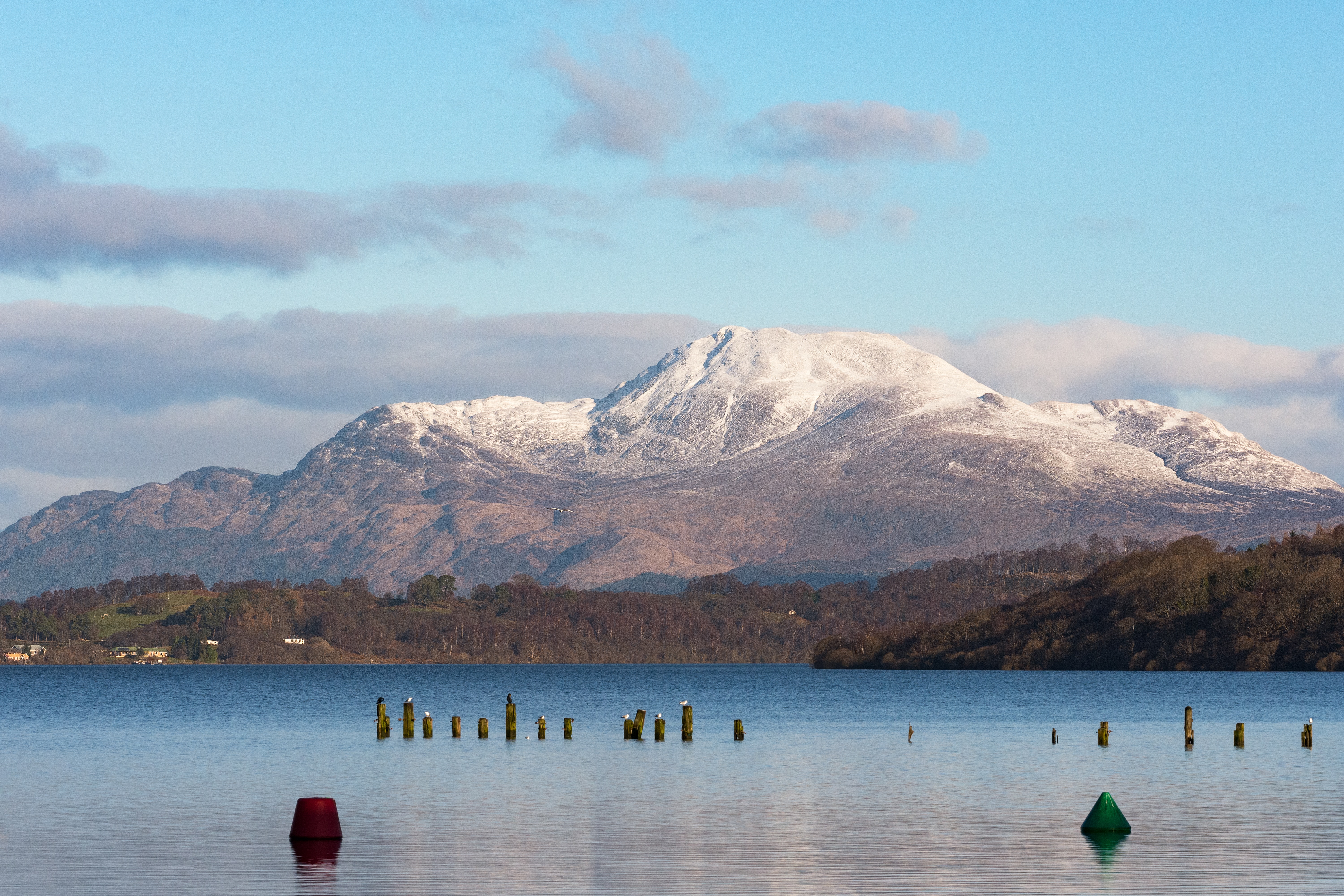 Ben Nevis, the highest peak in the UK is visible from our path
Ben Nevis, the highest peak in the UK is visible from our path
Route type/direction
Linear, from Fort William to Inverness. The recommended direction is from south-west to north-east so that prevailing winds are behind you. This also makes for a gentle introduction, with the first couple of sections low-level and easy going, mainly on towpath.
Overview
The Way begins at the ruins of the Old Fort, Fort William and runs the entire length of Scotland’s longest glen, following the Caledonian Canal, forest tracks and drove roads. It passes beside three major lochs: Lochs Lochy, Oich and Ness. There is good access to accommodation and shops as it passes through villages along the Great Glen, with an alternative option that includes Invergarry. The route ends at Inverness, the capital of the Highlands, at Inverness Castle. Although primarily a walking route, it is suitable also for riders of mountain bikes, provided they show respect for other users.
Highlights
- Neptune’s Staircase, and its views of Ben Nevis
- the Caledonian Canal – Thomas Telford’s historic work of engineering, including Neptune’s Staircase
- Achnacarry House (short detour) with its links to the Clan Cameron Museum and Commando training
- spectacular views over Loch Ness and the Great Glen from the High Route
- 17th century heritage in Fort William and Fort Augustus
- starts near the base of Ben Nevis, the highest mountain in the UK
Be aware
- some stretches of minor road walking, mainly around Gairlochy, Kilfinnan, Drumnadrochit and Abriachan
- limited accommodation in Gairlochy and South Laggan: use Spean Bridge/Invergarry as alternatives
The challenge
Starting from Fort William, the first few sections are undemanding, but after the mid-point (Fort Augustus) the route undulates, especially if you opt for the High Route. The overall ascent of 1835m/6020ft refers to the High Route which contains some steep sections, including a few very steep bits which are unsuitable for cyclists. (The overall ascent for the original route is much less, at 1230m/4035ft.) The highest point on the High Route is 422m (1385ft) between Invermoriston and Drumnadrochit. The section lengths varies between 9 and 20 miles (14-32 km) and most walkers will wish to split the 20-mile section between Drumnadrochit and Inverness, perhaps using transport to/from Blackfold or by camping at Abriachan. The terrain varies widely: canal towpath, forest track, old drove roads and former military roads, purpose-built path and urban pavement.
Accommodation
There is a range of accommodation options in the settlements along the route for walkers and cyclists, and for paddlers along the Great Glen Canoe Trail. You can find out more about these here or from the Visit Scotland website.
Wild camping is legally allowed in Scotland if practised responsibly under the Scottish Outdoor Access Code.
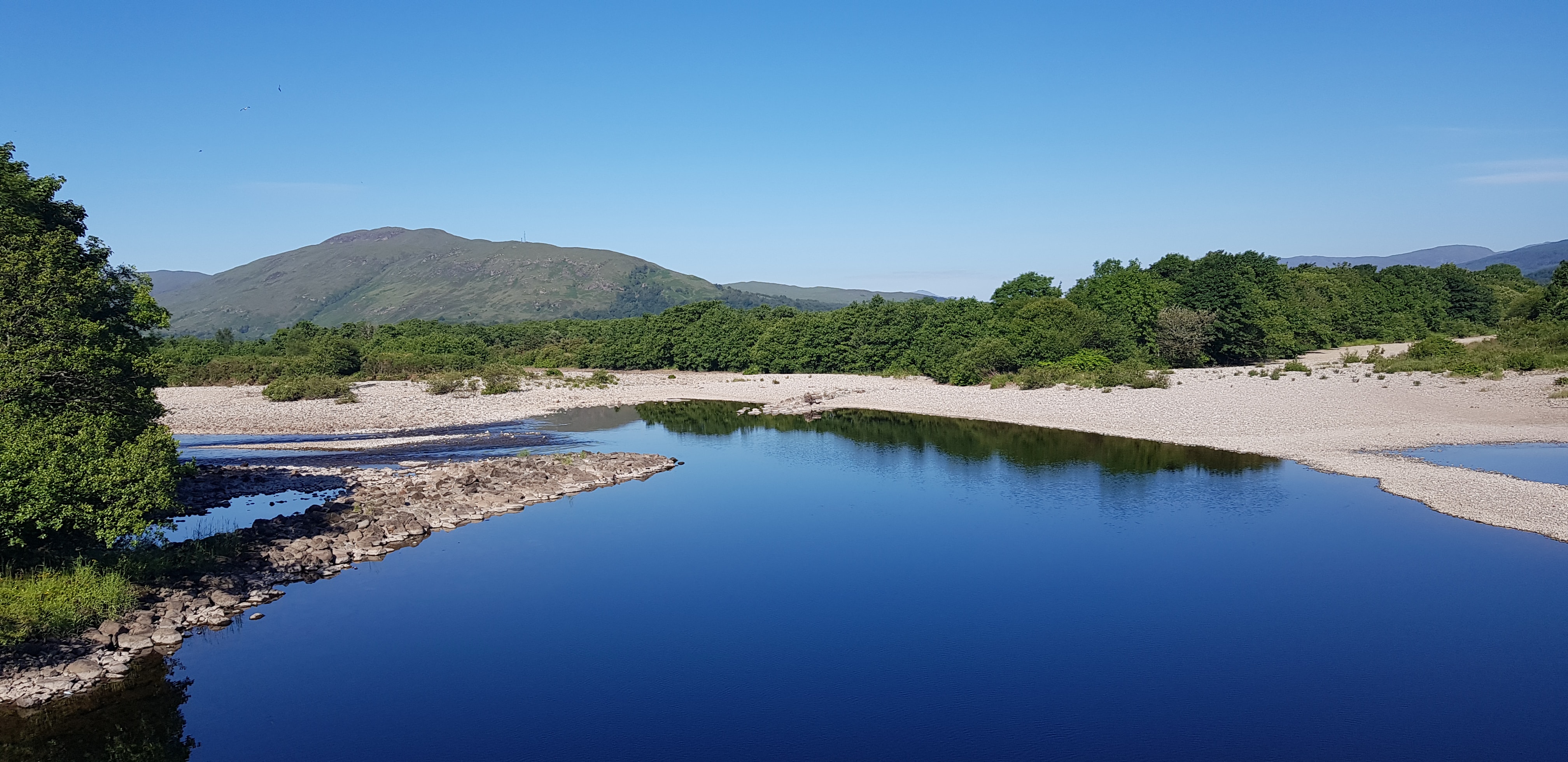
Arriving to Fort William
8. The Cateran Trail
- Distance: 64 miles
- Location: Blairgowrie, Perthshire
Embrace the charm of Scotland's glens with The Cateran Trail, one of Scotland's Great Trails. Covering 64 miles in the glens of Perthshire and Angus, this fully signposted route unveils the beauty of farmland, forests, and moors. The trail, known for its connection to the Caterans, cattle thieves from the Middle Ages to the 17th century, offers a full circuit that can be completed in five days. Alternatively, walkers can start at any of its five stages. For those seeking a shorter experience, a mini trail spanning two days concludes in the picturesque village of Kirkmichael. To ensure a smooth journey, walkers are advised not to stray from the track without a map or a guidebook.
Trail Type and Directions
The Cateran Trail beckons, inviting adventurers to traverse a captivating circuit through the heart of Scotland's Perthshire and Angus glens. This fully waymarked trail, boasting historical significance, can be embarked upon from various points. Traditionally, it begins with a 7.2-mile (11.6-km) spur from Blairgowrie to Bridge of Cally, where the main circuit unfolds. Travelers can choose to follow the trail either clockwise or anticlockwise, leading back to Blairgowrie, offering flexibility and diverse perspectives. Additionally, the Cateran Minitrail, a 20-mile (32-km) loop, provides a condensed yet enriching experience, showcasing the northern part of the main trail.
Overview: Tracing the Footsteps of Caterans
Delving into the Perthshire and Angus glens, the Cateran Trail weaves through landscapes steeped in history. Unveiling paths once trodden by the Caterans, notorious cattle thieves who marauded through Strathardle, Glenshee, and Glen Isla from the Middle Ages to the 17th century, this trail echoes with tales of the past. The Cateran Minitrail offers a two-day adventure, traversing scenic Strathardle and Glenshee, adorned with the remnants of hut circles and Iron Age structures. Geocaching enthusiasts can embark on a treasure hunt, with 20 special caches and a Cateran Trail Geocaching Passport, leading to unique rewards.
Highlights: Castles, Gardens, and Lochs
- Blackcraig, Dalnaglar, and Forter Castles: Explore remnants of Scotland's historic past.
- Prehistoric Buildings: Encounter the mystique of ancient structures along the trail.
- Upper Lunch Hut: Visit a spot once graced by Queen Victoria, near the trail's highest point.
- Dirnanean Gardens: Immerse yourself in the vibrant beauty of these gardens (open in summer).
- Auchintaple Loch and Loch Shandra: Discover the serenity of Scottish lochs.
- Mount Blair (744m/2440ft): Opt for a detour with breathtaking panoramic views.
Be Aware: Plan Accordingly for a Seamless Journey
- Limited Accommodation at Spittal of Glenshee: Plan your stay in advance.
- Map-and-Compass Skills: Essential for the Lair to Kirkmichael section of the Minitrail.
The Challenge: A Well-Marked Trail for All Abilities
The Cateran Trail, well-marked and traversing old drove roads and ancient tracks, accommodates a diverse range of abilities. Featuring stages varying in length from 8.5 miles/13.7 km to 15.5 miles/24.9 km, the trail can be comfortably completed in five days. With only one gradual climb to the An Lairig gate (648m/2130ft), this journey through history and nature awaits, promising an enriching experience for all who tread its path.
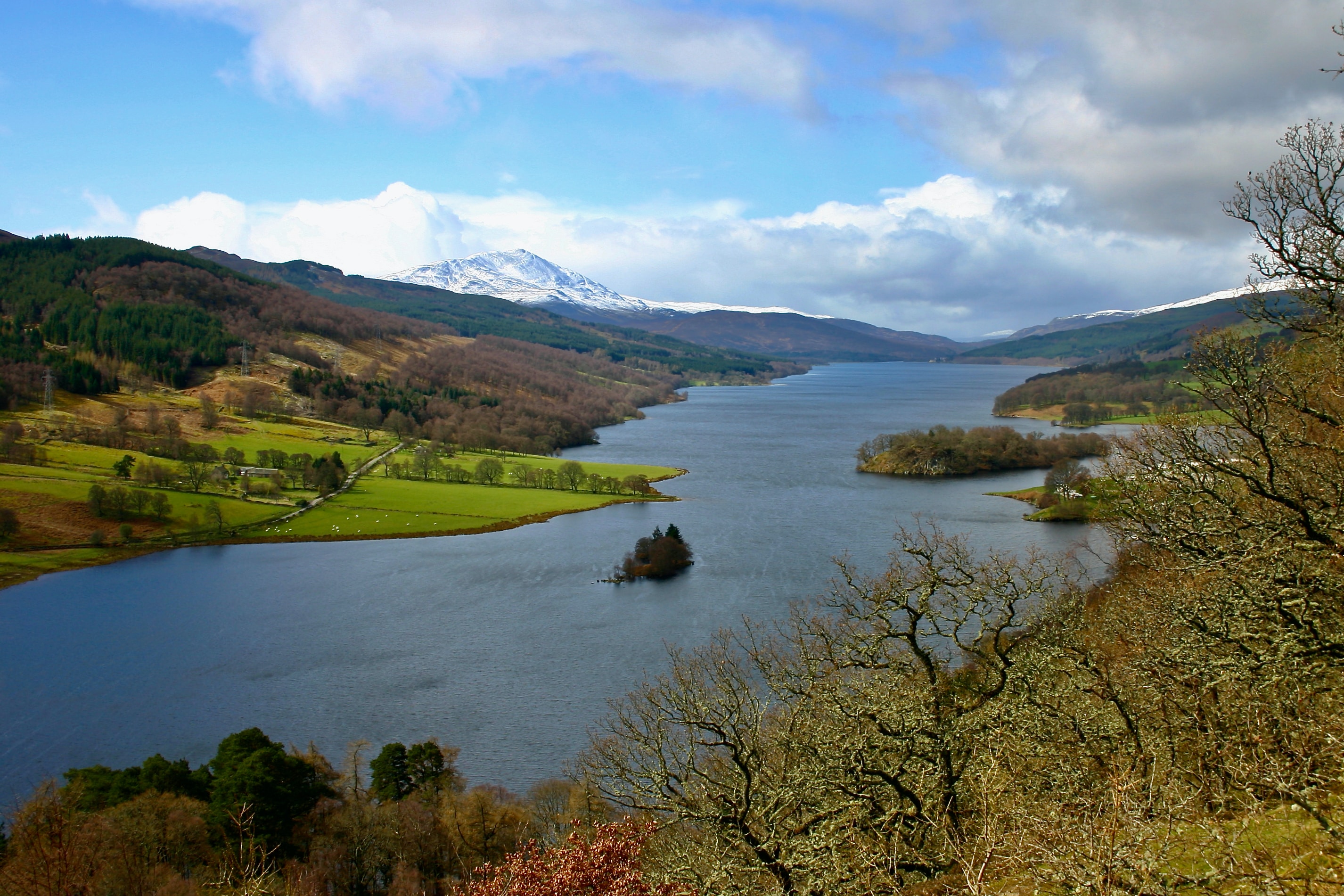
Beautiful Perthshire
9. The Borders Abbeys Way
- Distance: 107km
- Location: Jedburgh, Scottish Borders
Delve into the rich history of the Scottish Borders with The Borders Abbeys Way, a 107km circular route featuring some of the region's oldest historic abbeys, including Melrose, Dryburgh, Jedburgh, and Kelso. The walk can commence at any of its five stages in Jedburgh, Hawick, Selkirk, Melrose, or Kelso. As you traverse the route, picturesque countryside scenery unfolds, with sections along the River Tweed and River Teviot, renowned for salmon fishing. Take the opportunity to explore the charming towns and villages, with the flexibility to use public transport between stages.
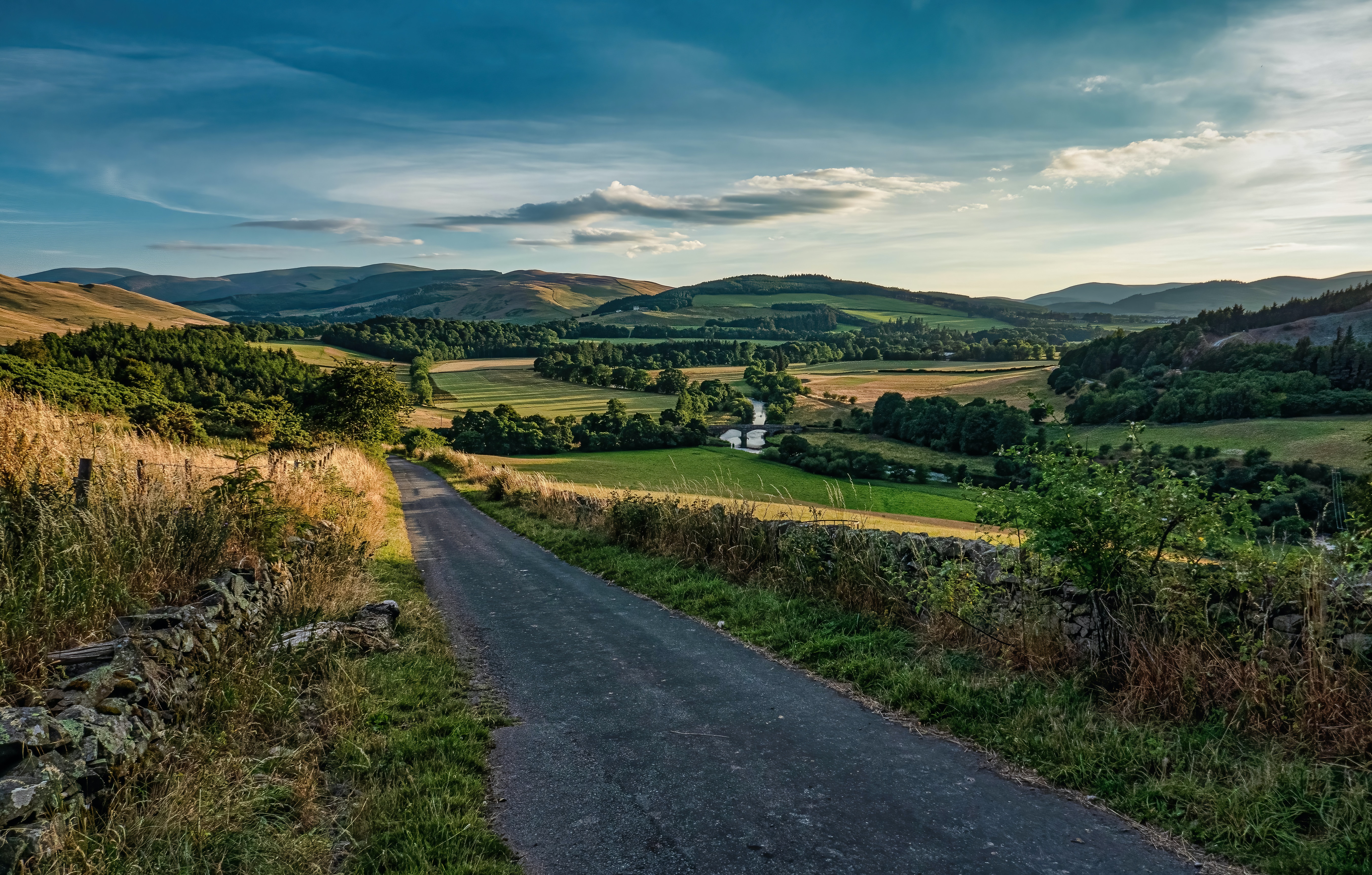 The Scottish Borders, South of Edinburgh
The Scottish Borders, South of Edinburgh
Trail Type and Directions: Exploring the Scottish Borders in Circuits
The Borders Abbeys Way invites exploration through the enchanting landscapes of the Scottish Borders, offering a circuit that can be initiated from various points. With Melrose now situated close to the Borders Railway terminus at Tweedbank, this location has become a popular starting point, although Jedburgh remains a cherished choice. Typically walked clockwise to maximize the scenic vistas, this circuit unfolds like pages from a history book, revealing the grandeur of ruined abbeys, the Rivers Tweed and Teviot, and the historic Abbotsford House, the residence of Sir Walter Scott.
Overview: A Tapestry of History and Nature
Embark on a captivating journey through historic towns and villages, tracing the remnants of four major ruined abbeys – Melrose, Dryburgh, Kelso, and Jedburgh. The trail gracefully meanders beside the Rivers Tweed and Teviot, offering picturesque riverside scenery, while also venturing into rugged hilly sections that showcase the beauty of the Cheviots. The warm embrace of Borders pubs, quaint cafés, and cozy B&Bs enhances the overall experience, creating a perfect blend of history, nature, and hospitality.
Highlights: Where History and Nature Converge
- Historical Abbeys: Immerse yourself in the rich history of Melrose, Dryburgh, Kelso, and Jedburgh abbeys.
- Riverside Scenery: Stroll along the banks of the Tweed and Teviot, two fine fishing rivers.
- Scenic Views: Marvel at panoramic vistas from high ground, gazing towards the Cheviots.
- Borders Hospitality: Enjoy the warmth of friendly pubs, inviting cafés, and comfortable B&Bs.
Be Aware: Navigating the Path with Care
- Map-and-Compass Competence: Essential for sections with poor visibility, particularly on Black Hill.
- Mixed Terrain: Some sections include tarmac roads and farm tracks, though less than many long routes.
The Challenge: A Well-Marked Journey for All Explorers
The Borders Abbeys Way, adorned with clear waymarks, caters to both seasoned and novice walkers. While it can be completed in five days, the initial section from Melrose to Kelso spans 18 miles (29 km), often prompting a slight detour for an overnight stay at St Boswells. With a moderate overall altitude gain (1300m/4265ft) and mostly solid terrain underfoot, this trail beckons adventurers to savor the allure of ruined abbeys and captivating side-trips.
Accommodation: Welcoming Villages and Cozy Stays
As the trail winds through charming villages, welcoming B&Bs dot the landscape, offering a comfortable haven for weary travelers. Booking in advance is advisable, especially during the bustling season, ensuring a seamless and enjoyable journey. Camping options are available, adhering to the Scottish Outdoor Access Code, allowing enthusiasts to embrace the Scottish wilderness responsibly.
10. The Kintyre Way
- Distance: 100 miles
- Location: Kintyre Peninsula
Embark on a mesmerizing adventure along The Kintyre Way, a waymarked route spanning 100 miles across the picturesque Kintyre peninsula. This trail weaves its way through charming villages and incorporates numerous popular visitor attractions, showcasing the best of this remote and untouched part of Argyll.
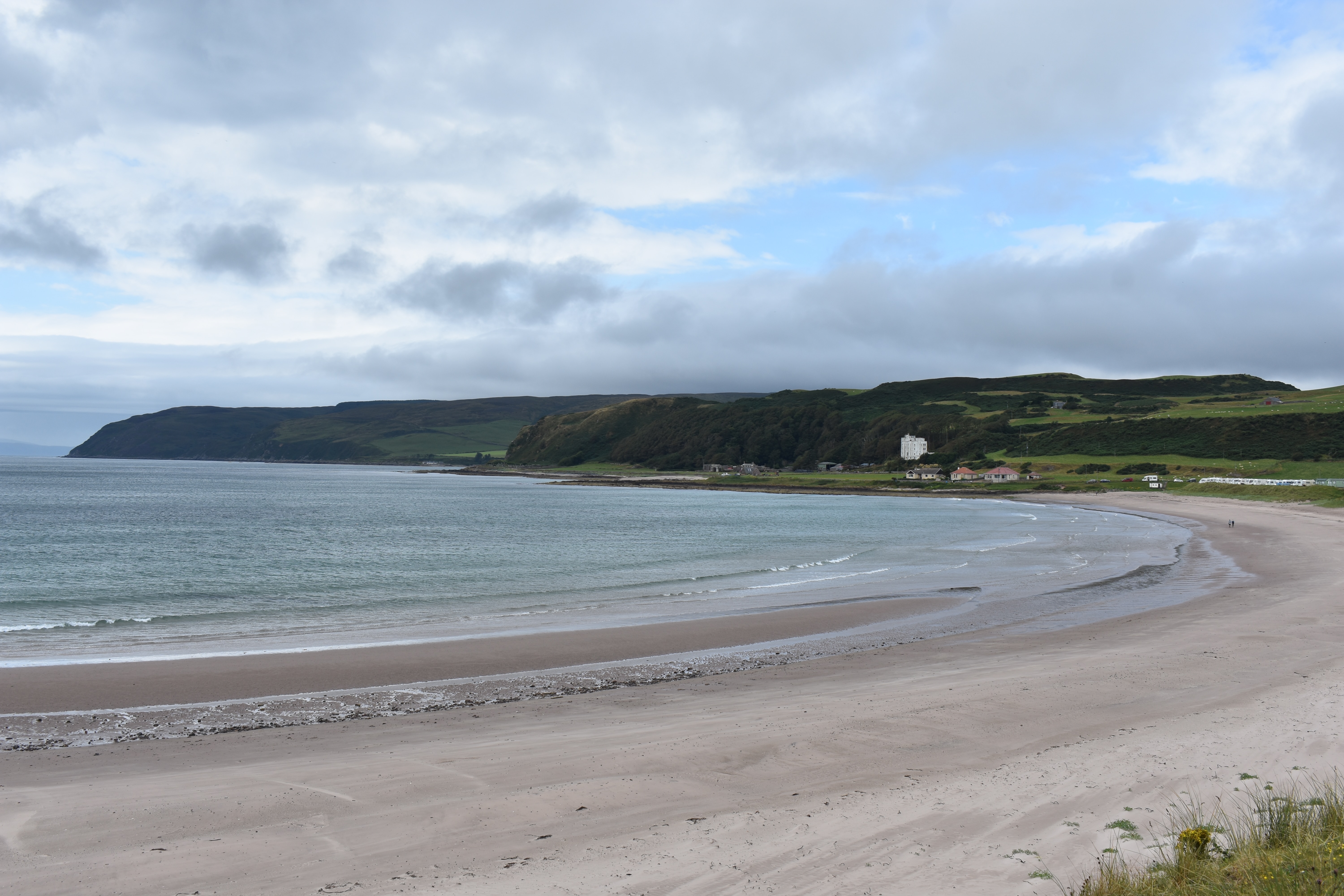
Get ready for stunning beaches in Kintyre
Key Highlights:
Diverse Landscapes: Traverse the length of the Kintyre peninsula, meandering from the rugged west coast with its deserted, sandy beaches pounded by Atlantic breakers to the gentler bays of the east coast. The ever-changing landscapes offer awe-inspiring views of Loch Fyne and even glimpses of Ireland on the horizon.
Wildlife Watching: Immerse yourself in the natural beauty and wildlife of Kintyre. Keep a lookout for seals, otters, and basking sharks in the waters, while red squirrels and orange-tip butterflies grace the woods. The trail's last section takes you through the Scottish Wildlife Trust nature reserve at Largiebaan on the Mull of Kintyre, providing opportunities to spot wild goats, kestrels, peregrines, and barn owls.
Health and Wellbeing: Beyond its scenic wonders, The Kintyre Way offers health and wellbeing benefits for walkers, runners, and cyclists. Whether you're seeking a long-distance adventure or a fun day trip, the trail accommodates various preferences.
Cultural Delights: Explore the communities along the route, connecting with local history and produce. One of the highlights is walking the wild 'Mull of Kintyre,' a place steeped in cultural significance.
Seating and Waymarking: The route is thoughtfully waymarked by blue posts adorned with the Kintyre Way logo. Mile marks guide your progress, and strategically placed seating made with local materials invites you to pause and absorb the breathtaking viewpoints along the way.
Plan Your Journey:
The Kintyre Way caters to all—whether you're a seasoned hiker, a casual walker, or a cycling enthusiast. Revel in the diverse landscapes, encounter fascinating wildlife, and relish the cultural richness of the Kintyre peninsula.
This concludes our exploration of Scotland's unmissable walking routes. We hope this guide inspires your next adventure amid the breathtaking landscapes and storied history of Scotland.
As we conclude our exploration of Scotland's unmissable walking routes, we've traversed landscapes rich in natural beauty, steeped in history, and teeming with the spirit of adventure. Whether you're drawn to the rugged terrains of the West Highland Way, the historic pilgrimage route of The Whithorn Way, or the enchanting shores of The Fife Coastal Path, Scotland offers a tapestry of experiences for every avid hiker.
Best Seasons to Walk:
1. Spring: Experience the awakening of nature, with blooming flora and milder temperatures. Spring is ideal for those seeking a quieter trek on popular routes like the West Highland Way.
2. Summer: Enjoy longer days and warmer weather, making it the perfect time for a trek along The Great Glen Way or The Kintyre Way. Be mindful of increased foot traffic, especially in popular destinations.
3. Autumn: Witness the landscapes adorned in golden hues. The fall season is excellent for exploring routes like The Cateran Trail and The Borders Abbeys Way, offering a more serene experience.
4. Winter: For those seeking a unique adventure, certain routes like The Southern Upland Way can be navigated during winter, but careful preparation for colder temperatures is essential. Also, for some routes, navigation skills and winter gear might be necessary. We can guide you or give you advice.
Your adventure awaits
Whether you're a seasoned hiker or a nature enthusiast, Scotland's walking trails cater to a spectrum of interests. From the majesty of Loch Ness on The Loch Ness 360° Trail to the coastal charm of The Southern Upland Way, each route unfolds a chapter of Scotland's diverse narrative.
Your Trusted Companion
- Kookoo Climb: If you're inspired to embark on these trails and desire a local guide to enhance your experience, Kookoo Climb stands ready to assist. Our local guides are passionate about sharing their knowledge, ensuring you make the most of your journey. From navigating the twists of The Whithorn Way to immersing yourself in the wildlife wonders along The Kintyre Way, Kookoo Climb is your companion in every step of the adventure.
Embark on your Scottish adventure with Kookoo Climb, where every trail becomes a story waiting to be explored. We look forward to being part of your unforgettable journey.
Happy hiking!


